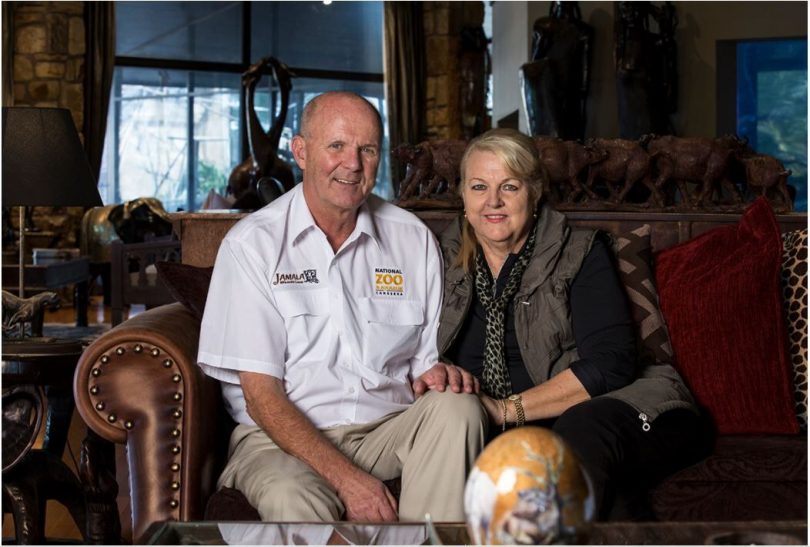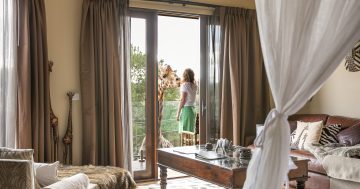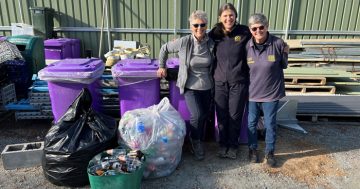
Happy 20th birthday to Canberra’s zoo! Pictured is Australia’s oldest wombat, Winnie, who last December celebrated her 31st birthday at the zoo. Photo: Glynis Quinlan.
The National Zoo & Aquarium is hosting a month-long party to celebrate its 20th birthday and mark its journey from an old wildlife park with a chequered past to a world-class zoo and animal lodge.
The theme of the birthday celebrations is ’20 Years of Conservation’ and includes the telling of the ‘We Built a Zoo’ story of the zoo’s owners, Richard and Maureen Tindale, who started virtually from scratch and built a renowned Canberra attraction which makes a strong contribution to animal conservation.
The celebrations started on Monday (2 July) and run through until Sunday 29 July, with visitor activities including special birthday tours, face painting, lucky door prizes, competitions and more.
Every weekend in July there will be a ‘party in the viewing park’ with fun keeper talks, while the special tours will operate every day of the birthday month.
The original National Aquarium was opened in 1990 and, after going into receivership twice in a short period, was purchased by Canberra businessman Richard Tindale and his wife in 1998.
“It was an aquarium with a small Australian animal park attached to it that didn’t quite know what it was and had gone into liquidation twice over the previous few years,” recalls Mr Tindale.

Richard and Maureen Tindale started virtually from scratch and have built a world-class zoo and animal lodge. Photo: Supplied.
“We had no animal care qualifications but were passionate about animals and particularly big cats, having spent many years visiting game reserves in Africa, South America, Canada, Alaska, Siberia, Mongolia, Nepal and India just to learn more about them and in the hope of seeing them in the wild.
“It became pretty obvious that a number of sub-species were extinct and a lot more would end up that way in the next generation.”
Together with their six adult children, the Tindales set about building a zoo that would allow animals to live in as spacious and open areas as possible.
They turned the existing bistro adjacent to the aquarium into their home (complete with a shark tank in the lounge room) so that they could live on site and oversee the zoo’s development.
“We then started looking into acquiring big cats. That was an almost insurmountable problem, as we had no zoological background and the aquarium had a very chequered history,” Mr Tindale said.
“We hired experienced staff from other zoos to get us going in the right direction. Our daughter Shelley went to Taronga Zoo to learn about zoology.
“She and our son Andrew had a background in aquaculture and we brought in our other children to help with the project. Three of them, Shelley, Ryan and Sharron are still fulltime at the zoo 20 years later.”
Mr Tindale said the only commercial considerations were to make the place survive and not go broke again.
“We began to rescue animals from circuses and private collections, where they had finished performing and had become liabilities.
“They came to us with dubious pedigrees (Tigons, a lion/tiger offspring, for example), had behavioural issues and were generally not wanted by mainstream zoos, but we just wanted to give them a decent retirement home.
“We also took in a Malayan Sun Bear rescued from a restaurant cage in Cambodia by Free the Bears, and other animals from various backgrounds,” Mr Tindale said.
“We started to see positive changes in the animals’ behaviour and health and gained credibility with regulators and zoological bodies.
“We then started looking at more ways to spread the conservation message and with some very talented staff, including the family, we developed award-winning animal encounters like our Meet a Cheetah program and the ZooVenture Tours.”

The Meet a Cheetah program has been popular at the zoo. Photo: Supplied.
Mr Tindale said that nothing beats people getting close to animals for the impact that it has on their perspective of animal conservation.
“These interactions not only allowed us to spread our message but to continue with our development and to financially support conservation in the wild.

Guests getting close to a Sun Bear at Jamala Wildlife Lodge. Photo: Supplied.
“Developing in-zoo accommodation was a natural extension of that. Jamala Wildlife Lodge was created to build on our contributions and to have an even greater impact on those who stayed there.
“Most of the proceeds from Jamala are directed towards conservation in the wild; charities; furthering our educational programs; and continuing with the expansion of the zoo,” he said.
“In many ways getting our accommodation product right can make a significant impact – while we can’t change the world, we can help change people’s outlook and make a difference to the future of animals in the wild. That motivates us every day.”
Mr Tindale said the zoo now has 191 employees “and they are all here for the right reasons”.
Today, the zoo successfully participates in a number of endangered animal breeding programs, including programs for the critically endangered Black & White Ruffed Lemur and Cotton Top Tamarin, and the endangered Red Panda, Ring Tailed Lemur, Siamang Gibbon, Tasmanian Devil and the Tree Kangaroo.

This Siamang Gibbon baby was born at the zoo as part of their breeding program. Photo: Supplied.
The zoo also contributes to a large number of animal conservation programs ranging from Mulligans Flat Wetlands to the Snow Leopard Trust.
To find out more visit the zoo’s website at nationalzoo.com.au and to find out more details about the 20th birthday celebrations please click here.





















